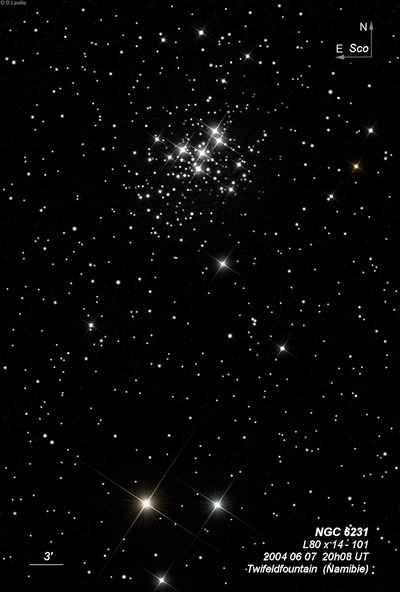
Giovanni Hodierna discovered NGC 6231 = Lac II-13 = D 499 = h3652 around 1650 from Sicily. Edmond Halley independently discovered the cluster in 1677 whle cataloging southern stars from the island of St. Helena. Discovery credit is often given to Nicholas-Louis de Lacaille, who observed it in 1751-1752 with a 1/2" telescope at 8x during his expedition to the Cape of Good Hope. He noted a "close group of seven or eight close faint stars". James Dunlop described "a cluster of pretty bright stars of mixt small magnitudes, considerably congregated to the centre, about 10' diameter, with a large branch of very small stars extended on the north side; this is 150 Scorpii." John Herschel wrote, "a fine bright, large cluster; pretty rich; class VII; 10'; stars 10...13 mag. Place of a double star 5m, the preceding but one of 7 bright stars in the middle."
Ashworth argues in the "Journal for the History of Astronomy" (1981) that Ptolemy listed NGC 6231 in his catalogue as a star (14 Scopii), though did not observe it as nebulous. It was included as a star or nebula, in every major catalogue and atlas since, but it's position and different labels were so inconsistent that it was not recognized as the same object found by Lacaille in 1752. For example, it was listed as Bayer's southern Mu, and Sharp's Zeta. It was depicted as the southern of a pair of stars in Bayer's atlas and the northern in Hevelius' atlas.
200/250mm - 8" (7/13/91 - Southern Baja): over 100 stars mag 8-12. Bright, very large, scattered. Divided into two main groups and fills the 40' field. Emission nebula IC 4628 is involved on the north side (seen from Baja) and a trail of stars extends towards NGC 6231.
8" (6/27/81): bright, large, scattered cluster in two main groups.
8" (7/13/91 - Southern Baja): bright group of stars in center like jewels over rich sprays of stars, excellent low power field. Located 30' N of Zeta Scorpii. Partially resolved in 8x50 finder.
8" (6/27/81): impressive cluster at 100x with a bright group of 8 stars in the center. Partially resolved in the 8x50 finder.
300/350mm - 13.1" (7/5/83): five bright stars are in the cluster with a dozen stars in the central portion and 50 stars in a 20' field. There is a 1° field to the NW and NE consisting of fairly bright stars = NGC 6227 and Tr 24 = H12.
400/500mm - 17.5" (7/4/86): 100 stars at 84x in the main part including 10 bright stars. Impressive cluster at low power.
Naked-eye - (numerous times): this is an easy naked eye cluster, even from northern California, looking like a comet heading north from Zeta Scorpii. From further south (southern Baja or southern Hemisphere), it is a very prominent naked-eye cluster.
Notes by Steve Gottlieb